A slot machine is essentially an electro-mechanical device. Learn the basic external components of a slot machine.
First, we have the slot machine cabinet which comes in various styles and sizes, from tall upright machines to low narrow body machines.
The top part of the cabinet is named the top box. This is where the Pay Table Glass is located and winning combinations are displayed. A bright light illuminates the Pay Table. Below the top box and covering the front of the machine we have the slot door which protects the inside of the machine. The lock is well secure so it will not easily be opened. There are two other illuminated display glasses, the reel glass, and the called belly glass. The reel glass covers the reels of the machine, indicating a single line or multiple lines where the reel symbols have to line up to make a winning combination. The belly glass is a decorative display glass which advertises the type of game being played. Located between the reel glass and the belly glass is a button panel where the buttons are situated as well as the coin insert mouth. Most machines have a bet one button, a max button, a spin button, and a coin attendant button. The size of the coin insert mouth varies according to the size of the coins played. A bill acceptor is situated next to or above the belly glass, enabling one to insert bills instead of coins. In addition, a play card insert is located for the player to keep a running count of the number of cycles played on that machine. The coin tray is located below the belly glass. To the right of the slot machine, we find the handle, which operates the same spin button found between the reel glass and the belly glass. The handle is there for a cosmetic reason only and does not influence the outcome of the game in any way. On top of the cabinet, we have the tower light. This light has two shades of color. One is for the jackpot and the other is for malfunctions, which requires the assistance of a floor attendant. The colors also describe the type of coin denomination being played.

The best daily bonuses on the internet
Our score:  (4.3 / 5)
(4.3 / 5)

Welcome Bonus
Our score:  (4.2 / 5)
(4.2 / 5)
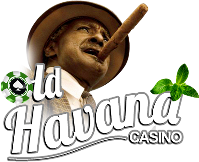
Welcome Bonus
Our score:  (4.2 / 5)
(4.2 / 5)

Bonus Code: 400BONUS
Our score:  (4.2 / 5)
(4.2 / 5)

Bonus Code: 400BONUS
Our score:  (4.2 / 5)
(4.2 / 5)
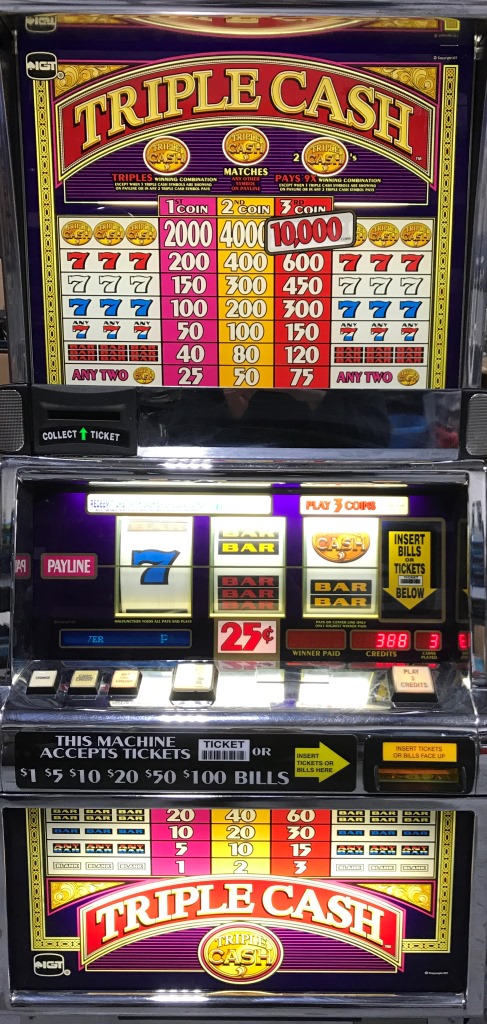
To understand the basic operation of a modern slot machine we will be using block diagrams throughout this section. A picture is worth a thousand words and hopefully, this method will greatly simplify our task without going to detail technical descriptions. Upon opening the door of a slot machine, we find a neat arrangement of electronic and mechanical components. Modern three reel-type slot machines evolved from mechanical type machines wherein mechanical clutches were relied on to stop spinning display reels at random locations to display a game result to today's machine where a microprocessor randomly selects a game result. Generating a greater number of random numbers than the number of available sets of different symbol combinations, and by varying the sizes of the subsets of random numbers which correspond to each different set of game symbols then the probability of a particular game result can be predetermined for the machine. The random number generator is the brain of the slot machine.
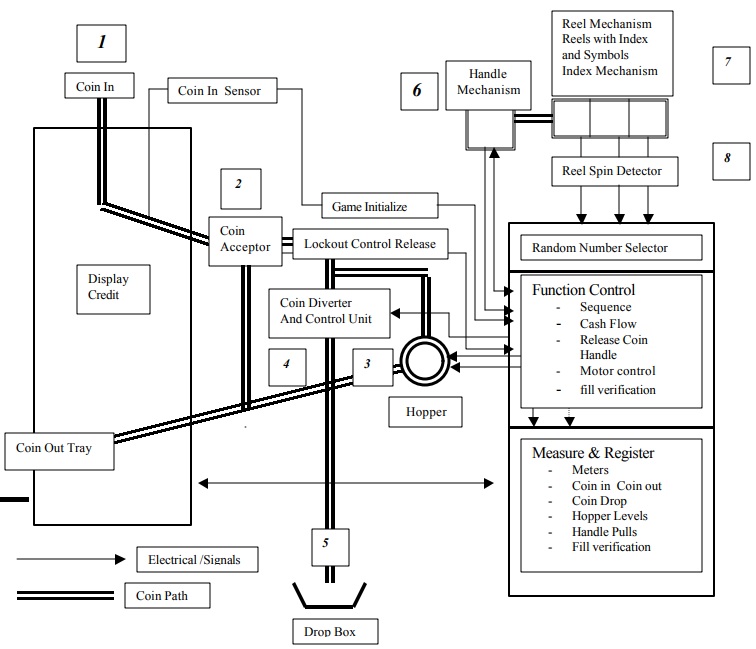
Coins are inserted into the slot (1) and detected by the coin acceptor (2). The coins pass along a conduit into a coin payout hopper (3). The level of coins in the payout hopper is sensed by a detector which when full causes the coin diverter mechanism (4) to deflect a paddle and divert the coins recorded into a coin counter to come to rest in a coin drop box (5). When the coins have been accepted, a signal energizes the game to start. If multiple coins are fed into the machine a circuit detects this fact and signals the control and payout logic of the number of coins inserted. Once the play button is pressed or the handle is pulled (6), a shaft is rotated to power the reel mechanism (7). A random number generator (8) programs selected position, causes the individual reel to stop and determines a payout. When the payout is complete, a signal passes to the main control unit and a new game is activated.
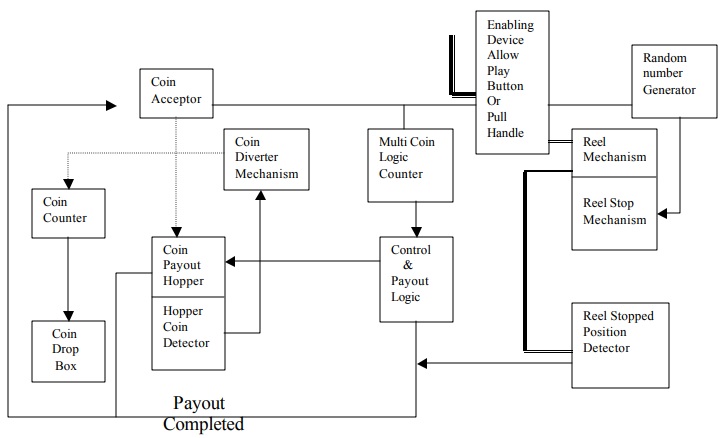
The hopper (3) is responsible for the paying out of coins into the coin tray. A hopper is a strong motor that turns a metal wheel. The wheel is a solid circular plate with raised pins that are spaced evenly apart towards the outer edge of the wheel. The distance between the pins is determined by the size of the coins that the hopper is required to pay out. The inner section of the wheel is also raised to enable a coin to rest on the wheel without slipping off. This wheel is large enough to hold up to a thousand coins. All the coins are controlled by the MPU , that is, how many coins are needed to be paid out. An optical sensor counts the coins as they leave the hopper. When the last coin has been counted, the computer sends a signal to the hopper motor brake to engage and instantly forces the motor to stop. The machine accepts the coins and verifies that they correct. This is done using a coin comparator. The coin is compared with a sample coin. Using magnetic coils, an electronic measurement can be determined to assess the magnetic properties of the inserted coins to that of the sample coin. Usually, there will be three coils placed strategically near the coin insert mouth. The sample coin will register a magnetic signal and when a coin is inserted, its property will be compared and information sent to an electronic comparator. If the two signals are identified, then the coin will be allowed to pass through and start the game, otherwise, a negative output will activate a solenoid to block the path of the coin and send it to the coin tray. Once, the coin is accepted, it will travel down and pass through two optical sensors. One sensor measures direction and the other time of travel. Should the direction change or the time vary from a predetermined time, the machine will activate an alarm and require the assistance of an attendant to rectify the situation.
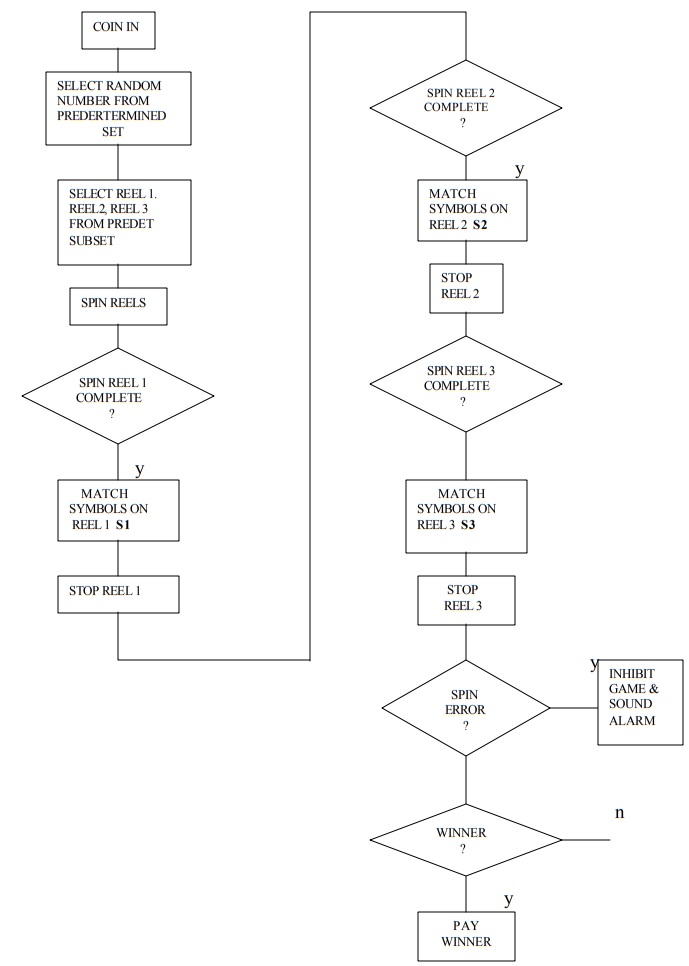
The random number generator selects a random number within a predetermined range of random numbers. For example, in a 32-bit system, the number may be one of 4,294,967,396 numbers in a range of 0 to 4,294,967,396. Then, this number is utilized in conjunction with a stored look-up table in a memory device called an EPROM (Erasable Programmable Read Only Memory) to select a game result comprising the three reel symbols S1, S2, S3. Next, all three reels are made to spin. The first reel continues to spin for a first predetermined free spin period, typically one second, and upon completion, a stopping procedure is initiated whereby signals developed by the game selected virtual stop are compared with signals corresponding to the desired game symbol S1. The stepper motor is interrupted and a stop routine is initiated to stop the display reel with the desired symbol displayed. In the meantime the second display reel continues to spin, and upon completion of a second predetermined spin period, also around one second, the signals generated by the symbol on reel 2 are compared with signals corresponding to the desired game symbol S2 and upon acceptance, a stop routine is initiated causing reel 2 to stop. Similarly, the third reel continues to spin for about a second and again a predetermined symbol initiates the stop. In the event of a spin error, the position of any one of the three reels, either as a result of the stepper motor slipping or failing to stop in response to a stepper pulse, an alarm is sounded and the game is stopped. If there are no spin errors, a determination is made whether the game results constitute a win and if so the hopper mechanism is actuated to provide a payout.
Thus far, we have gone through the operation of a slot machine and have a better understanding of how all the components fit together. The question a reader may have at this point in this book is how can we use this knowledge to increase our odds of playing slots. Well, there is a way to theoretically increase our odds of winning a jackpot. First, we need to have a detailed record of a given machine. Specifically, a knowledge of the payout that has gone for the life cycle of this machine, since theoretically, a given hold percentage will eventually bottom out and a winning number will appear. This period of time will depend on how long the machine has been active and the cycle of the machine. A machine with a low cycle will take a shorter time to complete a cycle than one with a larger cycle. For instance, a slot machine with a 32 stopper reel being played six times a minute, 24 hours a day will take
(32 x 32 x32 ) / { 6 play/min x 60 min/hr x 24/day } = 3.79 days
to complete a full cycle, while a machine with 128 stops per reel will take
(128 x 128 x 128 ) / { 6 play/min x 60 min/hr x 24 hr/day}=242.7 days
and for a machine with 256 stops per reel will take 5.32 years to complete its cycle of 16,777,216 combinations. Unfortunately, this information is available only to casino owners.
One of the most important results in probability theory is the law of averages, also known as the law of large numbers. This mathematical law provides an important connection between theoretical probabilities and observed the rules of random events. The law is summarized as follow:
In repeated, independent trials of the same experiment, the observed fraction of occurrences of an event eventually approaches its theoretical probability
Basically, it says that if you repeatedly play an "unfavorable" game, even though you are uncertain of the results of an individual play, in the long run, you will surely be a loser. How can we then make slot playing a profitable game? Well, the answer is found in common sense and there are simple rules that one can follow and reduce the odds of being a loser. The following guidelines will be helpful:
1) Play a high denomination machine if you can afford it for the higher the denomination the higher the payout percentage.
2) Keep your winnings from your buy-in amount, i.e. any money that you win keep aside with the only money you bet with being the money you budgeted for.
3) Play machine with a lower cycle. There is no way of knowing which machine has a short cycle but the machines with lower jackpot amounts generally have lower cycles.
4) Play machines that have "wild" symbols such as Double Diamonds, Triple Diamonds, Five Times Pay. These are the most popular machines among players and can increase your pay off